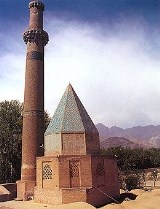
Natanz
Encyclopedia
Natanz is a city in and the capital of Natanz County
, Isfahan Province, Iran
. At the 2006 census, its population was 12,060, in 3,411 families. It is located 70 kilometres (43.5 mi) south-east of Kashan
.
Its bracing climate and locally-produced fruit (especially Natanz pear
s) are well-known in Iran
. The famous Karkas mountain chain (Kuh-e Karkas) (meaning mountain of vultures), at an elevation of 3,899 meters, rises above the town, and locals point in its direction telling how the Achaemenian King, Darius III, was killed nearby.
Various small shrine
s dot the area, such as the shrine of Abd as-Samad. The elements in the present complex date from 1304 with subsequent additions and restorations, such as the Khaneqah
and Muqarnas vault
. The tomb honors the Sufi Sheikh Abd al-Samad, and was built by the Sheikh's disciple, the Ilkhanid vizier
Zain al-Din Mastari.
.
Natanz County
Natanz County is a county in Isfahan Province in Iran. The capital of the county is Natanz. At the 2006 census, the county's population was 43,947, in 12,802 families. The county is subdivided into two districts: the Central District and Emamzadeh District...
, Isfahan Province, Iran
Iran
Iran , officially the Islamic Republic of Iran , is a country in Southern and Western Asia. The name "Iran" has been in use natively since the Sassanian era and came into use internationally in 1935, before which the country was known to the Western world as Persia...
. At the 2006 census, its population was 12,060, in 3,411 families. It is located 70 kilometres (43.5 mi) south-east of Kashan
Kashan
Kashan is a city in and the capital of Kashan County, in the province of Isfahan, Iran. At the 2006 census, its population was 248,789, in 67,464 families....
.
Its bracing climate and locally-produced fruit (especially Natanz pear
Pear
The pear is any of several tree species of genus Pyrus and also the name of the pomaceous fruit of these trees. Several species of pear are valued by humans for their edible fruit, but the fruit of other species is small, hard, and astringent....
s) are well-known in Iran
Iran
Iran , officially the Islamic Republic of Iran , is a country in Southern and Western Asia. The name "Iran" has been in use natively since the Sassanian era and came into use internationally in 1935, before which the country was known to the Western world as Persia...
. The famous Karkas mountain chain (Kuh-e Karkas) (meaning mountain of vultures), at an elevation of 3,899 meters, rises above the town, and locals point in its direction telling how the Achaemenian King, Darius III, was killed nearby.
Various small shrine
Shrine
A shrine is a holy or sacred place, which is dedicated to a specific deity, ancestor, hero, martyr, saint, daemon or similar figure of awe and respect, at which they are venerated or worshipped. Shrines often contain idols, relics, or other such objects associated with the figure being venerated....
s dot the area, such as the shrine of Abd as-Samad. The elements in the present complex date from 1304 with subsequent additions and restorations, such as the Khaneqah
Khaneqah
Khaneqah may refer to:*Khanqah, a type of Sufi architecture*Khaneqah, Afghanistan*Khaneqah, Ardabil, Iran...
and Muqarnas vault
Muqarnas
Muqarnas is a type of corbel used as a decorative device in traditional Islamic architecture. The term is similar to mocárabe, but mocárabe only refers to designs with formations resembling stalactites, by the use of elements known as alveole.Muqarnas takes the form of small pointed niches,...
. The tomb honors the Sufi Sheikh Abd al-Samad, and was built by the Sheikh's disciple, the Ilkhanid vizier
Vizier
A vizier or in Arabic script ; ; sometimes spelled vazir, vizir, vasir, wazir, vesir, or vezir) is a high-ranking political advisor or minister in a Muslim government....
Zain al-Din Mastari.
Nuclear facility
The Natanz Nuclear Facility, located some 30 km NNW from the town (33°43′N 51°43′E) near a major highway, is generally recognized as Iran's central facility for enrichment with over 5000 centrifuges currently operational and being fed with uranium hexafluorideUranium hexafluoride
Uranium hexafluoride , referred to as "hex" in the nuclear industry, is a compound used in the uranium enrichment process that produces fuel for nuclear reactors and nuclear weapons. It forms solid grey crystals at standard temperature and pressure , is highly toxic, reacts violently with water...
.

